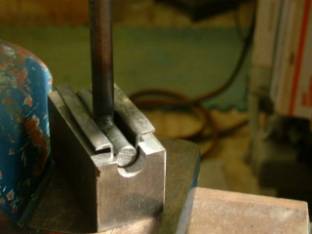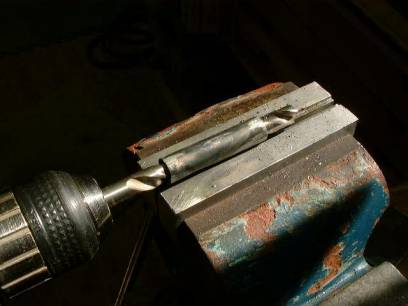
| Creating Ramrod Pipes |
By Jerry Crawford, Alfred, Maine
My
friend in Canada ask me about my ram rod thimble former set so I put this
essay together as a better explanation than I can write. Here’s the set. I
made it last week in my Wednesday night metals shop adult ed course at the
local high school. It consists of the swage block and two formers, a 3/8”
and a 7/16”.

For a 3/8" thimble I begin with a flat rectangular blank of my hammer forged iron that is about 2" long by 1 3/4" wide. My iron is about .050” thick. I know 2 inches is too long for most thimbles but I like to leave some spare on the length for holding and all the hammering needed during the forming. The ends are the first to be battered and having some to discard makes me feel better. I bend up two 1/4" sections along each long side that will become the tabs, or feet, that are inletted into the stock. This example is black from the torch I used in forming and bending the tabs. I was working close to the edge and wanted to prevent any cold splits if possible.

Lay the channel shaped blank down on the swages block with the tabs hanging down over the long edge. Align the former over the groove in the block on the center of the thimble blank and pound it into the “U” shape with a couple of whacks of a heavy hammer. I used a 2# blacksmith hammer for this job because iron is a lot tougher than brass. Pop out the former, remove the half formed thimble from the swage block and step to the bench vise. You can see here how the tabs lift up and begin to take shape as the feet for the thimble

Turn the thimble over, place a 3/8” section of CRS bar in side and use the vise as a press to squeeze the tabs together around the bar. I often have to do some cold forging and adjusting the tabs to get them to meet together correctly, but eventually they meet in the middle (or close) and I’m satisfied.

…this is about as close as you can get it without soldering it together. Brass will work down closer because it is less resistant to forming. I use to silver solder them together at this point but I’ve been told few originals were soldered so any more I don’t bother.

The final step is dressing up the rough form and doing the detail filing. I clamp the thimble in my bench vise and run a 3/8 drill bit down inside. This removes any stray chunks of metal that may have broken away during the forming and hammering and I know when I put them on the gun all the thimbles are the same size.

This thimble measures 2” long. As I related earlier, that’s too long for normal use but now I can remove length as I go about planning the shape and finish details for the thimble. Once I have the blanks laid out and cut it takes me about 2 hours to form up a pair of thimbles and shape the rear entry pipe receiver. Filing the flats and shaping the finial on the rear pipe is another matter.

This article is Copyright 2003 by Jerry Crawford and is published with the permission of the author .
| American Longrifles Home | Back | Gun Building Home |
This page was last updated on 04/01/05 .